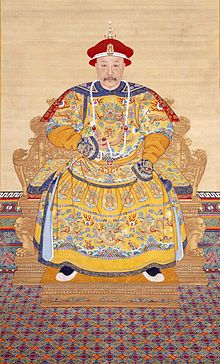
Image Source: Public Domain
About Jiaqing Emperor
Lifespan: 1760 – 1820 A.D
Reign Years: 1796 – 1820 A.D
Given Name: Yongyan
Reign Name: Rénzong

Image Source: Public Domain
Lifespan: 1760 – 1820 A.D
Reign Years: 1796 – 1820 A.D
Given Name: Yongyan
Reign Name: Rénzong
Yong Yan was known and respected as the Jiaqing Emperor. Or, he was also referred to as Emperor Renzong of Qing.
He was one of the more caring and ambitious leaders of the empire. Plus, he was considered an ordinary ruler of the Qing Dynasty.
He was one of the people who were able to experience the most thriving times. However, he was also one who saw the progressive decline of the Qing Empire.
With that, the Jiaqing Emperor spent most of his rule attempting to deal, and even stop the nation’s rising problems. He even aimed to recover the prosperity and excellence of his kingdom.
Basically, he was a diligent and qualified ruler when maintaining his empire. However, he wasn’t an innovative leader who could make huge and notable changes, nor could he adequately solve social issues.
Go back in time and follow the timeline and emperors of the Qing Dynasty.
Read MoreYongyan was the 15th son of Emperor Qianlong. His mother was the Noble Consort Ling, a daughter of Wei Qingtai. The latter was a Han-Chinese official whose clan had been long-integrated into the Manchu’s Eight Banners.
Originally, the Qianlong Emperor also considered two other sons for succeeding him as the ruler of the Qing dynasty. However, they both died from sickness.
So in December 1173, he secretly opted for Yongyan to succeed the throne. Then in 1789, Emperor Qianlong named Yongyan as Prince of Jia of the 1st Rank.
Hence, when Yongyan was thirteen, he was already considered the successor of the Qing empire’s throne.
After a few decades, Yongyan succeeded the throne when his father was 46. However, he only acquired actual power upon his father’s death.
In October 1795, the Qianlong Emperor announced his decision to abdicate in the 60th year of his reign. He made this decision out of respect to his grandfather, the Kangxi Emperor, who ruled for 61 years. He thought it would be disrespectful to rule the Qing empire longer than the latter.
With that, Prince Jia ascended the throne, taking the reigning title Jiaqing in 1796. For the next three years, the Jiaqing Emperor ruled only in name.
During this period, the power was still held by his father, who became Taishang Huang or emperor emeritus after abdicating. Taishang Huang was an honorific used to refer to retired emperors in Ancient China.
When the Qianlong Emperor died in February 1799, the Jiaqing Emperor took full control of the Qing empire. He prosecuted Heshen, Qianlong’s favorite official.
Heshen was accused and charged with corruption and abuse of power, so his titles were removed. Also, his properties were confiscated, and he was ordered to commit suicide.
Princess Hexiao, Heshen’s daughter and the Jiaqing Emperor’s sister, was spared from undergoing the penalty. She received a few properties from her brother’s estates.
At that time, the Qing empire was facing an internal disorder. Specifically, these were the White Lotus and Miao rebellions, as well as the empty imperial treasury. The Jiaqing Emperor attempted to appease the empire and reduce the rebellions.
Jiaqing aimed to return the prosperity and power that China had in the 18th century. However, the large outflows of silver that were paid for the smuggled opium caused the economy to decline.
Richly decorated and full of interesting details, this rare vase from the late Ming Dynasty seeks to imitate the drawing style of the Yuan Dynasty. The base is adorned with elegant arches that makes way for a seductive waisted body.
Buy Now!This blue and white porcelain plate is finely painted in light cobalt tones, flower blossom is painted in the center surrounded by double enclosed ring with three gates. The plate show rust spots and it is marked at the bottom.
Buy Now!Antique Chinese Red underglazed porcelain Kendi, the body is painted with fish swimming surrounded by plants and flowers, the bottom is marked with a couch shell a symbol of royalty, dignity and high rank.
Buy Now!On September 2, 1820, the Jiaqing Emperor died at the Rehe Traveling Palace, located at the northeast of Beijing. The imperial court was in summer quarters. However, the Draft History of Qing didn’t record the Jiaqing Emperor’s actual cause of death.
There are allegations stating that the Qing Dynasty emperor died after being struck by lighting. Others claim that he was obese, while some theories state that he died due to a stroke.
His second son, Mianning, succeeded the throne of the Qing Dynasty as the Daoguang Emperor.
Join the VIP club, Get Auction notification, special offers and more!